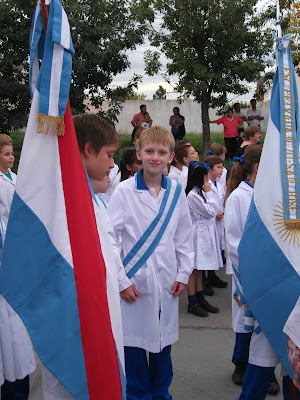¡Hola!
I've
finally got a blog up and running and I will try and have a weekly
update ready for you every Monday morning (New Zealand time).
Today
it is exactly one month since I boarded the plane in Auckland New
Zealand and arrived in Buenos Aires Argentina.
I
am based in a town called Crespo,
it is in the province of Entre Ríos and has a population of about
20,000. It is a town based around agriculture and is the poultry capital of
Argentina. It has a strong German heritage and many people are
descendants of Volga Germans who migrated from Russia to Argentina from 1875 onwards. There are
many places and people with German names but German is no longer
spoken or taught in schools.
Crespo
doesn't get many (if any!) tourists; there is an American student and
a German student both doing an AFS exchange but as far as I know we
are the only foreigners! Nobody here has ever met a New
Zealander so I have been talking a lot about myself and our country.
Today
I thought I would share three important things about Argentinian
culture that I have learnt about since being here.
Numero
Uno: Besos (beh-sos)
The
way people in Argentina greet one another with a beso (kiss) is
fascinating!
Argentinians
kiss each other on the cheek when they meet or say goodbye; whether
they are close friends or strangers who have just been introduced is
not important. People make contact with right cheeks, and make a
light “kiss sound” but not touch the cheek with their lips. In
most places it is just once but there are certain regions in the
country where a kiss on both cheeks is the norm. It’s more common
among men with women and women with other women. And even though
Argentinian society is generally quite macho men still kiss each
other. Trying to shake hands when offered a kiss would be considered
strange.
Numero
Dos: Siesta (si-es-ta)
People
in Argentina like to have a siesta
and the day is built around it. Schools typically have a morning
school from 7.30am - 12.30pm and an afternoon school from 1pm- 6pm
(students go to one or the other). Shops operate during similar hours
and in Crespo the whole town shuts down from 12pm – 4pm (even the
supermarkets close!).
While
it might sound appealing to have a sleep in the afternoon I think it
is something that your body needs to get used to; I find it hard to
fall asleep straight after lunch! And because people are accustomed
to having a siesta it means that they like staying up later at night.
A normal time for dinner in the weekday would be 9pm. And if you get invited somewhere in the weekend for dinner don't expect to get
home before 2am!
Numero
Tres: Mate (mah-tay)
EVERYONE
in Argentina drinks a type of tea called mate. Although
mate is much more than a simple drink. It is an elaborate ritual,
shared among family, friends and coworkers. One person, the cebador
(server) fills the mate gourd almost to the top with yerba mate and
then adds hot water. The person then drinks it through a special
straw called a bombilla. The cebador keeps filling the gourd and
passing it to the next person (the yerba does not need to be changed
for some time). If you do not want any mate simply say “gracias”
and the server will know to miss you out. At first I found mate
extremely bitter and not very nice but as I have drunk more the taste
has definitely grown on me. I am however, still getting used to
sharing a straw with people that I hardly know! The preparation
and drinking of mate is a cultural practice that truly
transcends ethnicity, class and occupation.







